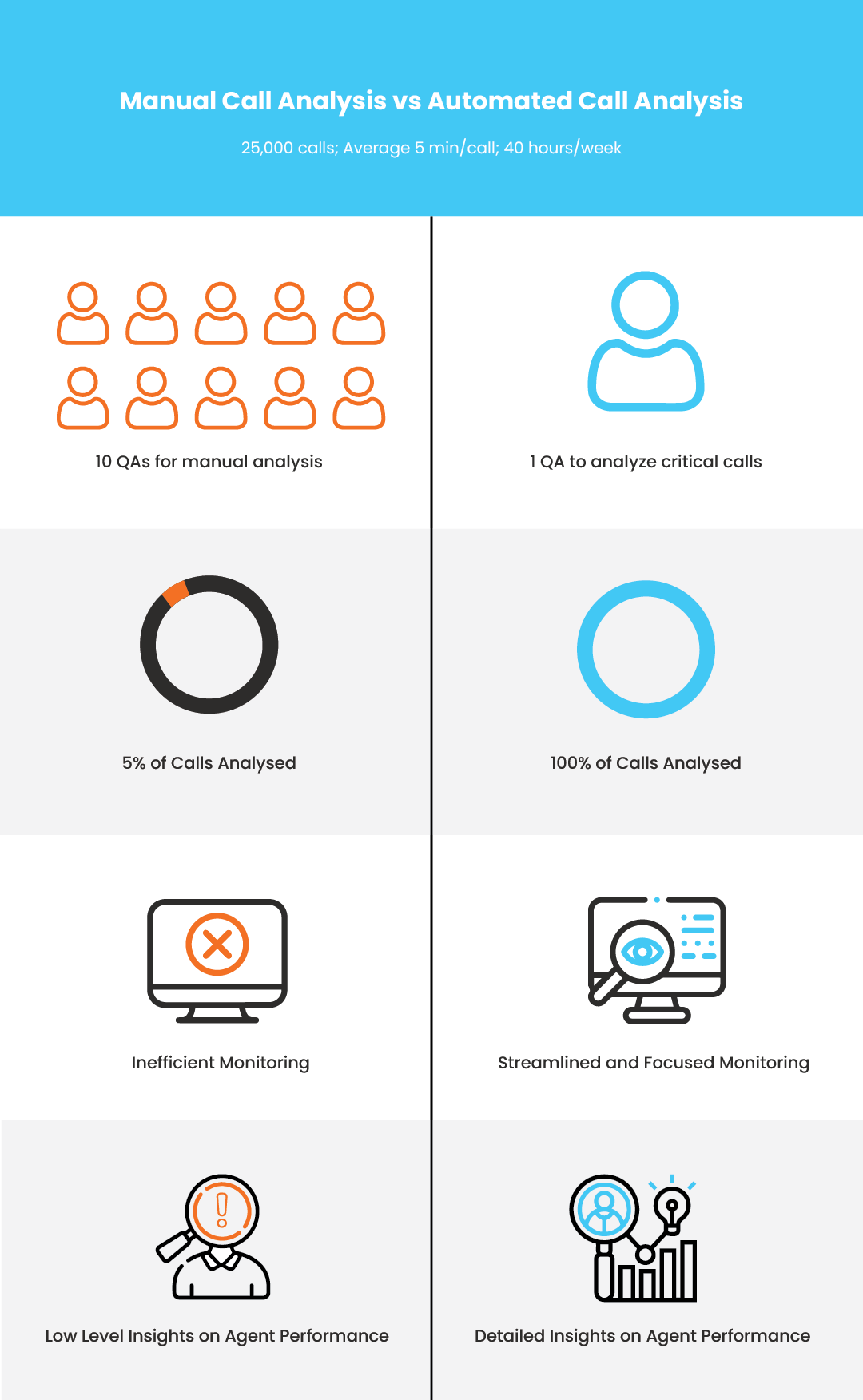In the current business landscape, contact centers must prioritize call quality monitoring and assurance. Analyzing the voice of the customer is now a customary practice to fulfill the expanding needs of the customer base and overall improve customer satisfaction with the services.
However, if your contact center managers are still relying on manual call monitoring, you may not be accurately tracking your agents’ performance or the overall customer experience. You may miss out on crucial metrics that measure subjective behaviors that have a high impact on customer satisfaction and overall customer experience. Furthermore, you may be incurring hidden expenses.
Let’s take a closer look at those hidden costs and how conversational intelligence can improve your business significantly.
Higher costs but not-so-valuable insights
Businesses consider gaining visibility into agent performance as one of the critical objectives of call monitoring in contact centers. However, manual call monitoring can be a tedious and expensive process that often yields limited insights. This is primarily because the Quality Assurance (QA) team randomly selects calls and analyzes them, which doesn’t provide a comprehensive understanding of an agent’s overall performance.
Furthermore, relying on manual call monitoring makes it difficult to identify areas where agents require additional training or assistance, as it becomes more challenging to pinpoint specific gaps in their performance. In addition, the absence of automated reporting can make the process even more time-consuming and costly.
Instead, conversational intelligence solutions can automate the process of call analysis and, consolidate and analyze agent performance metrics in individual scorecards or custom reports. This ensures accuracy and consistency in assessing agent performance while providing complete visibility and transparency in the contact center. By implementing a conversational intelligence solution, contact centers can streamline operations, reduce hidden costs, and improve overall business performance.
To illustrate this point, let’s consider a contact center that receives 25,000 inbound calls each month, with an average call duration of 5 minutes. As shown in the image below, it would take ten times the number of managers to manually listen to each call.
Conversational intelligence solutions automate and offer the capability to analyze 100% of calls and provide a wide range of insights. The agent performance metrics are presented in individual scorecards or customized reports, enabling accurate assessments of agent performance. This approach streamlines and focuses the analysis, enabling Quality Assurance (QA) teams to further scrutinize the calls based on detailed insights, promoting complete transparency and visibility in the contact center.
In contrast, manual monitoring can miss out on opportunities to enhance customer service as subjective behaviors that influence customer satisfaction can remain unnoticed. Analytics powered conversational intelligence provides a more comprehensive understanding of the customer experience, making it possible to target and address specific areas for improvement that can increase customer satisfaction and loyalty.
Costs of Errors and Non-Compliance
Listening to calls manually is a process that is subject to human error. This is particularly evident when monitoring script compliance. In regulated industries, relying solely on manual monitoring can put businesses at risk of non-compliance. This, in turn, can result in significant costs in terms of penalties, litigation fees, and other related expenses.
A single non-compliant event on one call with a customer can have far-reaching consequences. Therefore, it is important for contact center managers to be proactive in identifying and addressing these issues. By creating scorecards based on mandatory script guidelines, managers can automate the process of identifying compliance issues. This eliminates the need to listen to every call for script compliance, reducing both the time and resources required for this task.
Automating this process not only reduces the risk of non-compliance but also minimizes the costs associated with it. By ensuring that agents are following mandatory script guidelines, businesses can avoid unnecessary legal expenses and penalties. This is a cost-effective solution that provides peace of mind for managers and helps to ensure that businesses operate within regulatory compliance.
Along with live agent assist solutions, automated after-call analysis can allow easy identification and categorization of escalations into various buckets, such as internal, legal, social, and management. This applies to all inbound/outbound calls, chats, or emails.
Cost Of Agent Attrition
The high rate of agent attrition can have a significant impact on contact centers, both financially and operationally. Losing an agent can cost anywhere from 90% to 200% of their salary, resulting in a substantial burden on a company’s budget. With contact center turnover rates averaging between 30-45%, managers must focus on reducing attrition rates and improving the hiring and onboarding process.
According to HFS Research, the attrition rate in India is far higher than the average global attrition rate of 20.4%, making it crucial to reduce attrition rates. Even losing one agent per month can result in tens of thousands of rupees in costs each year. While agent monitoring may not seem like a direct solution to high attrition rates, it can be beneficial in many ways.
Automated solutions can be used to improve agent morale, which can help reduce employee dissatisfaction and improve retention rates. For example, agent dashboards and scorecards allow agents to see the impact of their work, which can make them feel valued within the company. Additionally, these tools offer opportunities for competition and rewards, further increasing engagement.
Sentiment dashboards are also useful for visual learners, providing agents with a clear understanding of how customers are reacting during conversations. Overall, while it may not be possible to eliminate agent attrition entirely, implementing measures to reduce it can have a significant positive impact on a business’s success.
Inconsistent Agent Training
Regular monitoring of agent performance is crucial for businesses to maintain consistency and drive excellence in their customer service. All members of the team, from agents to executives, need to focus on the same key performance indicators (KPIs) to achieve the organization’s goals.
However, manual monitoring of agent performance can be time-consuming and often lacks consistency. On the other hand, analytics powered by conversational intelligence offers objective insights into agent behavior immediately, accurately, and with little human effort or bias. Managed SaaS solutions are an ideal choice because they provide ongoing support and help set up scorecards to meet specific business goals.
Using conversational intelligence solutions not only offers objective insights into agent performance but also allows businesses to identify areas of improvement quickly. It provides consistent feedback to agents, which can help boost their performance and offers real-time visibility into customer interactions, allowing businesses to make data-driven decisions to improve their customer service. SaaS solutions offer businesses the flexibility to scale their operations and integrate with other technologies. This means that as the business grows and evolves, the QA solution can evolve with it, providing ongoing support for the organization’s goals.
To ensure your business delivers exceptional customer service, you require contact center agents who are skilled in handling customer interactions with professionalism and expertise. However, this may come at a cost. Investing in a conversational intelligence solution upfront can help you save a significant amount of money in the long run. You can streamline your agent training process and improve agent performance by monitoring their interactions with customers. This, in turn, can help enhance customer satisfaction and reduce the number of customer complaints. Therefore, while investing in a conversational intelligence solution may require an upfront cost, it can ultimately save your business money by improving customer service and reducing operational costs.







